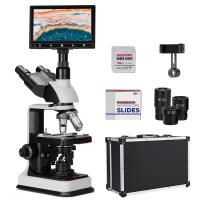What Would An Electron Microscope Be Used For ?
An electron microscope is a powerful scientific instrument used for imaging and analyzing samples at a very high resolution. It uses a beam of electrons instead of light to magnify the sample, allowing for much greater detail to be observed. Electron microscopes are commonly used in various fields of science and research, including biology, materials science, nanotechnology, and forensic science. They can be used to study the structure and morphology of biological specimens, such as cells and tissues, as well as the composition and arrangement of materials at the atomic and molecular level. Electron microscopes have contributed significantly to our understanding of the microscopic world and have enabled breakthroughs in many scientific disciplines.
1、 High-resolution imaging of microscopic structures and particles.
An electron microscope is a powerful scientific tool used for high-resolution imaging of microscopic structures and particles. It utilizes a beam of accelerated electrons instead of light to magnify and visualize objects at a much higher resolution than traditional light microscopes. This allows scientists to study the intricate details of various materials and biological specimens at the nanoscale level.
One of the primary applications of electron microscopy is in the field of materials science. Researchers use electron microscopes to examine the atomic and molecular structure of materials, such as metals, ceramics, and polymers. By studying the microstructure, scientists can gain insights into the material's properties, behavior, and performance. This knowledge is crucial for developing new materials with enhanced properties for various applications, including electronics, aerospace, and medicine.
In the field of biology, electron microscopy plays a vital role in understanding the structure and function of cells and tissues. It allows scientists to visualize cellular organelles, protein complexes, and even viruses with exceptional detail. This information helps in unraveling the mechanisms of diseases, studying cellular processes, and developing new drugs and therapies.
Moreover, electron microscopy has found applications in nanotechnology, where it is used to characterize and manipulate nanoscale structures and devices. It enables researchers to observe and analyze nanoparticles, nanotubes, and nanowires, which are essential building blocks for nanotechnology-based applications.
In recent years, electron microscopy has also been used to study biological samples in their natural, hydrated state. This technique, known as cryo-electron microscopy, has revolutionized structural biology by allowing scientists to visualize biomolecules, such as proteins and viruses, in their native environment. This has led to breakthroughs in understanding the molecular mechanisms of diseases and the development of new drugs.
In summary, an electron microscope is used for high-resolution imaging of microscopic structures and particles. Its applications span across various scientific disciplines, including materials science, biology, nanotechnology, and structural biology. With advancements in technology, electron microscopy continues to push the boundaries of our understanding of the microscopic world.

2、 Analysis of material composition and surface morphology at nanoscale.
An electron microscope is a powerful tool used for the analysis of material composition and surface morphology at the nanoscale. It utilizes a beam of electrons instead of light to magnify and visualize objects with extremely high resolution. This technology has revolutionized various scientific fields, including materials science, biology, chemistry, and nanotechnology.
One of the primary applications of an electron microscope is in materials science. It allows researchers to examine the atomic and molecular structure of materials, providing valuable insights into their composition, crystallography, and defects. This information is crucial for understanding the properties and behavior of materials, which is essential for developing new materials with improved performance and functionality.
In the field of biology, electron microscopes have been instrumental in studying the intricate details of cells, tissues, and microorganisms. They enable scientists to visualize the ultrastructure of biological samples, such as organelles, cell membranes, and viruses, at a level of detail not achievable with traditional light microscopes. This has led to significant advancements in our understanding of cellular processes, disease mechanisms, and drug development.
Furthermore, electron microscopes play a vital role in nanotechnology research and development. They allow scientists to manipulate and characterize nanoscale structures and devices, such as nanoparticles, nanowires, and nanotubes. This is crucial for advancing nanotechnology applications in fields like electronics, energy storage, and medicine.
In recent years, electron microscopy techniques have also been combined with other analytical techniques, such as spectroscopy and tomography, to provide even more comprehensive information about materials and biological samples. For example, energy-dispersive X-ray spectroscopy (EDS) can be used in conjunction with electron microscopy to determine the elemental composition of a sample, while electron tomography allows for three-dimensional imaging of complex structures.
Overall, the use of electron microscopes has become indispensable in scientific research and technological advancements. It continues to push the boundaries of our understanding of the nanoscale world and has a wide range of applications in various fields.

3、 Investigation of biological samples, cells, and subcellular structures.
An electron microscope is a powerful tool used for the investigation of biological samples, cells, and subcellular structures. It provides researchers with a detailed and high-resolution view of these microscopic entities, allowing for a deeper understanding of their structure and function.
One of the primary applications of electron microscopy in biology is the study of cellular ultrastructure. By using an electron microscope, scientists can visualize the intricate details of cells, such as the organelles within them, the arrangement of proteins and lipids, and the overall architecture of the cell. This level of resolution is not achievable with traditional light microscopy, making electron microscopy an invaluable tool for cell biologists.
Furthermore, electron microscopy is crucial for the investigation of subcellular structures. It allows scientists to examine the fine details of organelles like mitochondria, endoplasmic reticulum, and Golgi apparatus, providing insights into their morphology and function. This information is essential for understanding cellular processes, such as protein synthesis, energy production, and intracellular transport.
In recent years, electron microscopy has also been used to study the three-dimensional structure of biological samples. Techniques like electron tomography and cryo-electron microscopy have revolutionized the field by enabling the visualization of complex structures in their native state. These advancements have led to breakthroughs in understanding the structure of viruses, protein complexes, and even whole cells.
Moreover, electron microscopy has found applications in various fields beyond biology. It is used in materials science to investigate the structure and properties of nanomaterials, in forensic science for the analysis of trace evidence, and in environmental science to study pollutants and microorganisms.
In conclusion, an electron microscope is an indispensable tool for the investigation of biological samples, cells, and subcellular structures. Its high-resolution imaging capabilities have provided scientists with a wealth of knowledge about the intricate world of the microscopic, leading to advancements in various scientific disciplines.

4、 Study of crystallographic properties and atomic arrangements in materials.
An electron microscope is a powerful tool used for the study of crystallographic properties and atomic arrangements in materials. It allows scientists to observe and analyze the structure and behavior of materials at the atomic and molecular level.
One of the primary uses of an electron microscope is in the field of materials science. By using high-energy electron beams, electron microscopes can provide detailed images of the surface and internal structure of materials. This enables researchers to study the arrangement of atoms, the presence of defects or impurities, and the overall crystallographic properties of the material. This information is crucial for understanding the material's properties, such as its strength, conductivity, or optical behavior.
In recent years, electron microscopy has also played a significant role in the field of nanotechnology. With the ability to image and manipulate materials at the nanoscale, electron microscopes have become essential for the development and characterization of nanomaterials. They allow scientists to observe the unique properties and behaviors of nanomaterials, such as quantum effects or surface plasmon resonance, which are not observable with conventional microscopes.
Furthermore, electron microscopy has found applications in various scientific disciplines, including biology, chemistry, and physics. In biology, electron microscopes are used to study the structure of cells, tissues, and biomolecules, providing valuable insights into their functions and interactions. In chemistry, electron microscopy helps in the analysis of chemical reactions, the characterization of catalysts, and the investigation of molecular structures. In physics, electron microscopes contribute to the study of fundamental particles, the behavior of materials under extreme conditions, and the exploration of new physical phenomena.
In conclusion, an electron microscope is a versatile tool that is used for the study of crystallographic properties and atomic arrangements in materials. Its applications span across various scientific fields, enabling researchers to gain a deeper understanding of the microscopic world and advance our knowledge in numerous areas of science and technology.







































